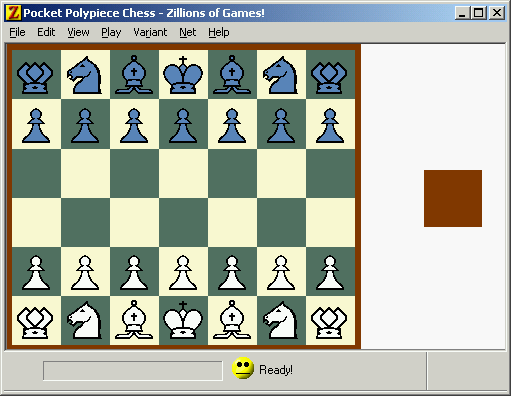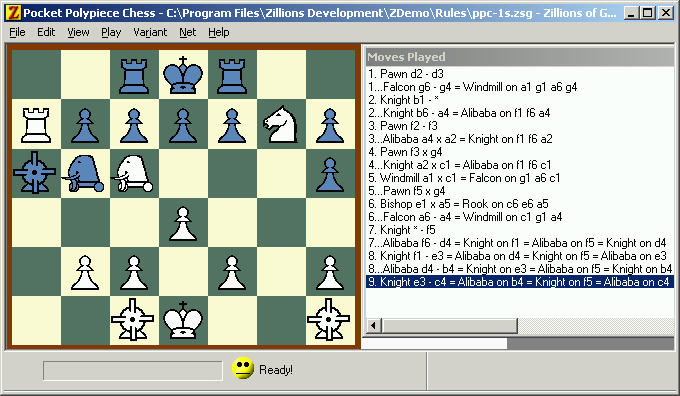Pocket Polypiece Chess 43
By Antoine Fourrière
Introduction
When I read Ralph Betza's article about Polypieces, I thought I would use them in bigger variants, to free Immobilizers from a "till death do us part" encounter, or to create a jumper-rider, namely the Drago(o)n - a two-form polypiece alternating Fergus Duniho's Dragon in British Chess, which could be referred to as an Alibaba-rider, and a Nightrider renamed the Dragoon.
However, I noticed two things.
- 43 = 42 + 1, so I could borrow one Pocket from Michael Nelson's Pocket Mutation Chess and use a no-nonsense 7x6 board.
- When I tried to implement the Drago(o)n on my favourite 12x8 pattern, Zillions lost too much steam and the game also felt a bit off balance. Since a Rook/Bishop and a Knight/Alibaba do not suffer from colorboundness either, why not use polypieces as a way to overcome the 43-square limitation, like John William Brown did in Flip Chess?
Board and Setup
Polypiece Pocket Chess is played on a board made of two parts, a 7x6 rectangle to which I'll refer as the 42-zone and a unique teleporting square, the Pocket.

|
|
The Falcons/Windmills, Knights/Alibabas and Bishops/Rooks start as Falcons, Knights and Bishops.
The Pieces
The King and the Pawns move as in International Chess, except that the Pawns are not permitted an initial two-square move.They may not enter the Pocket.
The Bishop and the Rook also move as in International
Chess, but after completing a move starting and ending on the
42-zone, all pieces belonging to the same polypiece flip. Thus
when a player moves his Rook or his Bishop from and to the 42-zone,
all Rooks become Bishops and all Bishops become Rooks. (A Rook or
Bishop in the Pocket doesn't flip.)
The Rook and the Bishop may also travel from the Pocket to a square on
the 42-zone and vice-versa, provided that the destination square is
empty. Such a move induces no flip.
The Knight also moves as in International Chess, and the
Alibaba (see here) moves as an Alfil
or a Dabbabah, that is, the Alibaba leaps two squares diagonally or
orthogonally. The move of a Knight or an Alibaba starting and ending
on the 42-zone also flips all Knights into Alibabas and all Alibabas
into Knights on the 42-zone. (A Knight or Alibaba in the Pocket
doesn't flip.)
The Knight and the Alibaba may also travel from the Pocket to a square
on the 42-zone and vice-versa, provided that the destination square is
empty. Such a move induces no flip.
The Falcon is sometimes known as the Lion - and not the Leo. It is a jumping Queen. Whether it captures or not, there must be exactly one piece of either color between its starting square and its destination square.
The Windmill is described in the Piececlopedia,
here.
It was invented by Alexandre Muniz for his game The Royal Standard. It
revolves around one of its eight neighbors, clockwise or
contra-clockwise, and may capture the first piece it runs into, if
that piece belongs to the enemy. Hence it is technically known as a
curve rider. (It cannot rotate back to its starting square.) The move
of a Falcon or a Windmill starting and ending on the 42-zone also
flips all Falcons into Windmills and all Windmills into Falcons on the
42-zone. (A Falcon or Windmill in the Pocket doesn't flip.)
The Falcon and the Windmill may also travel from the Pocket to a
square on the 42-zone and vice-versa, provided that the destination
square is empty. Such a move induces no flip.
Just like the Rook, the Bishop, the Knight and the Alibaba, the Falcon and the Windmill capture as they move, and there are three polypieces, a straight rider polypiece, a leaper polypiece and a supported rider polypiece. (Technically, they probably should be called twopieces. But polypiece seems clearer.)
Other rules
The game is conducted by the rules of International Chess, except where noted otherwise. There is no castling. Stalemate or perpetual check is a draw.A Pawn on the sixth line promotes into any polypiece.
A player may move a piece to or from the Pocket to give or escape mate.
The play of the game
A Bishop/Rook has nearly the value of a full Rook. A Falcon/Windmill seems nearly as strong as a Bishop/Rook in the midgame (certainly, a full Windmill is stronger than a full Falcon on 7x6), but not in the endgame, although the Pocket alleviates their dwindling mobility.
The Pawns have less ground to cover, but the officers have extra
capabilities, so their relative strengths are probably unchanged.
Still, King + 3 Pawns is a win vs. King + Knight/Alibaba and a draw
vs. King + Bishop/Rook and King + Falcon/Windmill.
King + 2 Officers vs. King is always a win.
King + Bishop/Rook vs. King was a win two days ago, a draw yesterday
and is probably a win today, but I have a lot of doubts.
King + Falcon/Windmill vs. King is a draw.
King + Knight/Alibaba vs. King is a draw.
Here's the final position of a short sample game. The Pocket - * - is empty.
(Zillions had one second for each move.)

Variants
Several variations come easily to mind.- Synchronous Pocket Polypiece Chess extends the flips to the Pocket (both to moves to and from the Pocket and to pieces within the Pocket). Promotion cannot break the synchronicity, that is, if there are Rooks and Windmills on the board, a Pawn may promote only to Rook, Windmill, Knight or Alibaba.
- Antisynchronous Pocket Polypiece Chess also extends the flips to the Pocket, but Black begins with Rooks, Dabbabbas and Windmills. Promotion cannot break the antisynchronicity, that is, if one player has only a Rook and the other a Windmill, the owner of the Rook may promote a Pawn only to Rook, Falcon, Knight or Alibaba.
- Cube Pocket Polypiece Chess forbids a player to re-enter the Pocket before his opponent has done so.
- River Pocket Polypiece Chess enables a Pawn which has crossed the River, that is, which is on its fourth or fifth line, to enter the Pocket.
- OrthoPawn/BerolinaPawn Pocket Polypiece Chess has also Polypiece Pawns.
Zillions
The ZRF caters to the aforementioned variations, but not to a combination of them.Since Zillions doesn't take mutations into consideration, I added bogus points. You can open the ZRF and change the relative values of pieces by adding or substracting some (500-points)-commands. (I have given points to the Kings when they are on the center squares. Otherwise Zillions doesn't manage to give mate with some combinations.)
Written by Antoine Fourrière. WWW page created: April 8th, 2003.
